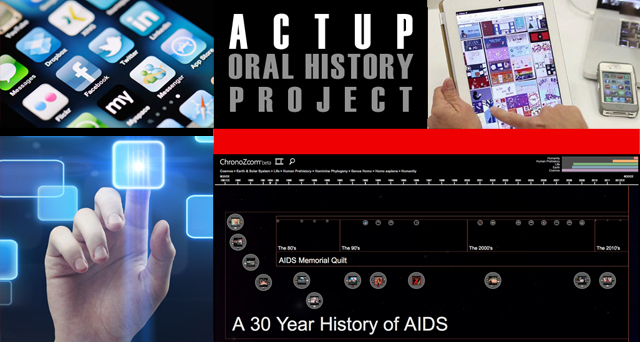There are many great resources and innovative projects that highlight the relationship between AIDS 2.0 and Web 2.0 — and I’ve listed a sampling of what’s available here. Many of these strive to narrow the gay generation gap in meaningful ways by initiating conversations about the social and health-related challenges facing gay men, as well as by producing cultural memory of the AIDS epidemic as an ongoing phenomenon. Make AIDS history and join the conversation.
Getting Started
- AIDS.gov: Some useful guidelines on the use of social media by the U.S. Department of Health and Human Services (HSS).
Awesome and Innovative Projects
- AIDS Quilt Touch: A mobile web app for exploring the AIDS Memorial Quilt. Developed by Anne Balsamo at the Annenberg Innovation Lab at the University of Southern California.
- AIDSVu: An interactive online map illustrating the prevalence of HIV in the U.S. The state and local maps allow users to locate HIV testing and treatment centers. Maintained by Patrick Sullivan at the Rollins School of Public Health at Emory University.
- Microsoft Research AIDS Timeline: An interactive timeline situating the AIDS epidemic with the larger context of human history. Part of the ChronoZoom project.
- Microsoft Research Digital Exhibit of the AIDS Memorial Quilt: An online exhibit that allows visitors to zoom in and out on over 49,000 panels — representing over 94,000 names — of the AIDS Memorial Quilt.
- PBS/Frontline: AIDS in Black America: An interactive graphic charting the spread of HIV in African American communities. A co-curricular component of the Frontline documentary, ENDGAME: AIDS in Black America.
Gay Related Projects
- HIV Big Deal: A useful online resource — including short videos — to motivate gay men to have safer sex and to get tested for HIV. A joint project by Public Health Solutions and New York University’s Steinhardt School of Culture, Education, and Human Development.
- In the Moment TV: A web-based soap opera about gay life in West Hollywood that doubles as an HIV/AIDS prevention and education campaign. Visitors who create accounts participate in online discussions.
- Many Shades of Gay: A campaign to encourage gay men to get tested every six months. High on the fun factor: to get started, users are invited to create a personal avatar. Collaboratively developed by the San Francisco AIDS Foundation, local health agencies, and community providers.
Archiving the Past
- ACT UP Oral History Project: A collection of interviews with surviving members of the AIDS Coalition to Unleash Power, New York. Available are short 5-minute samples of 135 interviews and complete transcripts. Coordinated by Jim Hubbard and Sarah Schulman.
- The Bay Area Reporter Obituary Database: A searchable database of all obituaries that have appeared in the Bay Area Reporter since it began publishing them in 1979. A partnership between the GLBT Historical Society of Northern California and the Bay Area Reporter.
- The Estate Project: A national registry of artists with AIDS. Developed by the Alliance for the Arts in 1991, at the height of the AIDS crisis.
- Gay History Wiki: A “social network of dead people,” as described by the Wiki’s creator, Chris Bartlett. Entries on the 4,600 gay Philadelphia men who died of AIDS during the eighties and nineties — close to 20 percent of the gay male population in that city. Visitors are invited to participate by adding their own stories and photos.
- Robert Giard Photograph Collection: Photographer Robert Giard’s portraits of American poets and writers, including Allen Barnett, Essex Hemphill, Larry Kramer, Audre Lorde, Kate Millett, Paul Monette, and Vito Russo. Housed at the Beinecke Rare Book and Manuscript Library at Yale University.
Archiving the Present
- GENERATIONS HIV: A “new media AIDS Quilt for the 21st Century,” in the words of its creator, Marc Smolowitz at the HIV Story Project. Videos of participants who shared their stories at a storytelling booth.
- GENERATIONS HIV (Demo): An interactive collection of answers, questions, and stories from the digital storytelling booth.
The Blogosphere
- Living in the Bonus Round: Steve Schalchlin’s personal blog. Tagline: “I was supposed to die, but I wrote a musical instead.”
- Outlier: My Unusual Journey with HIV: A personal blog by “fogcityjohn” housed at The Body’s HIV/AIDS Blog Central.
- Positive Indeed: Richard Cordova’s personal blog housed at The Body’s HIV/AIDS Blog Central.
- POZ Blogs
- Queer, Poz, and Colored: The Essentials: Brendan Lacy Campos’ personal blog housed at The Body’s HIV/AIDS Blog Central.
- Towleroad’s AIDS/HIV Hub
Facebook: Several important documentaries were released in 2011 to mark the occasion of the 30th anniversary of the AIDS crisis, and some viewers first learned about these films via Facebook. Upcoming films are also being introduced via this social networking site.
Pinterest: A new way of sharing interests with online pinboards. While this is a relatively new service (whose potential is still unclear at the present moment), here are two examples focusing on HIV/AIDS:
- Ignite Health. A healthcare marketing agency.
- Red Pump Project. An advocacy group that raises HIV/AIDS awareness among women.
